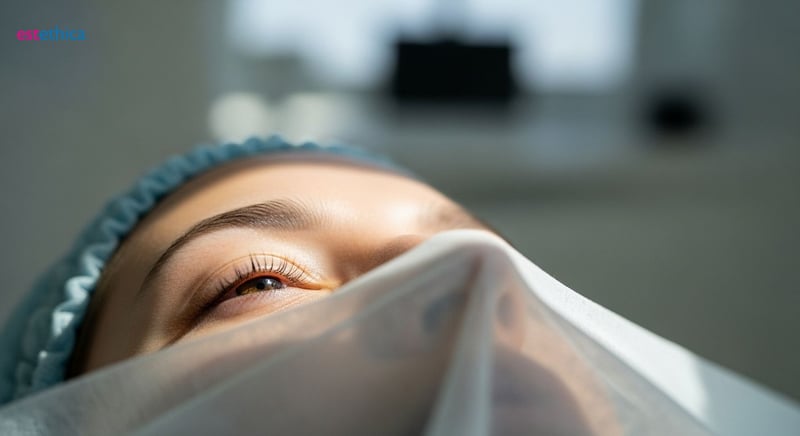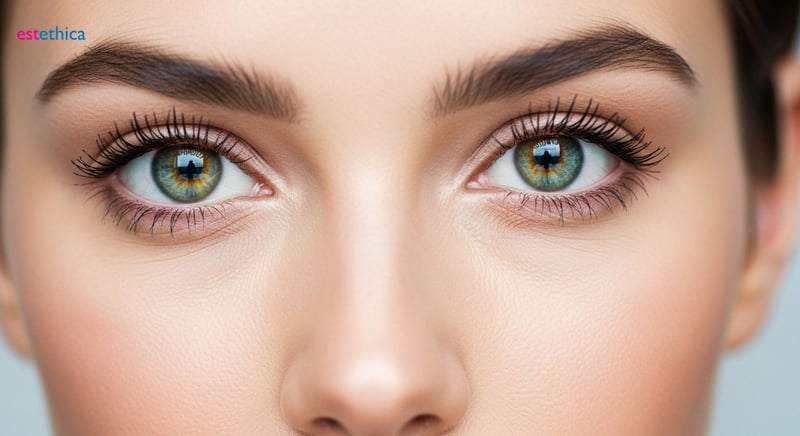Blepharoplasty: Renew Your Vision, Reclaim Your Youthful Eyes
Blepharoplasty not only enhances your visual aesthetics but also boosts your eye function. Renew your vision and reclaim youthful eyes today.
Blepharoplasty, or eyelid surgery, is a transformative procedure combining aesthetic enhancement with functional benefits. Often emerging as a solution for both cosmetic desires and medical needs, blepharoplasty addresses concerns ranging from drooping eyelids to vision obstruction, rejuvenating your appearance alongside improving your quality of life.
Understanding Blepharoplasty: More Than Just Cosmetic Eye Surgery
Beyond Aesthetics: The Functional Benefits of Blepharoplasty
While often discussed for its cosmetic advantages, blepharoplasty, or eyelid surgery, offers significant functional improvements. This procedure, which involves the removal of excess skin and fat from the eyelids, can dramatically enhance vision, particularly in cases where drooping upper eyelids obstruct the field of sight. For instance, patients suffering from severe dermatochalasis, a condition where excess eyelid skin impairs vision, often find considerable relief and improved quality of life post-surgery. Cosmetic Eye Surgery addresses not only the aesthetic appearance but also the physical well-being of individuals.
Conditions Addressed by Blepharoplasty
- Visual Obstruction: Removes drooping upper eyelids that block vision, improving the ability to see clearly.
- Eye Strain: Eliminates the need to constantly raise eyebrows to see, reducing forehead fatigue and headaches.
- Cosmetic Concerns: Addresses puffiness and bags under the eyes, providing a more youthful and refreshed appearance.
For example, a 55-year-old patient who could barely read due to sagging eyelids reported a significant improvement in their vision and a boost in confidence after undergoing Blepharoplasty. In many cases, eye lift operations significantly contribute to improving the quality of life of individuals with visual impairments due to excess eyelid skin.
The Blepharoplasty Procedure: What to Expect
The process of blepharoplasty is tailored to meet each patient's unique needs and anatomical structure. Typically, the surgery involves making precise incisions along the natural lines of the eyelids, minimizing visibility of scars. Through these incisions, excess skin, muscle, and fat are removed or repositioned to create a smoother and more youthful contour around the eyes. Recovery involves a period of rest and careful wound care, with most patients returning to normal activities within a few weeks. According to a recent survey, 85% of patients report high satisfaction with the results of their blepharoplasty, citing improvements not just in appearance but also in overall comfort and functionality of their eyes.
Steps in a Typical Blepharoplasty Procedure
- Consultation: A thorough examination and discussion of goals to determine the best surgical approach.
- Surgery: Precise incisions and removal/repositioning of excess tissue under local or general anesthesia.
- Recovery: Post-operative care including cold compresses and prescribed medications to minimize swelling and discomfort.
Consider a 60-year-old patient who had been suffering from chronic eye irritation due to her drooping eyelids rubbing against her eyelashes; after undergoing upper eyelid surgery, she not only regained clear vision but also found relief from the constant irritation. Another case involves a 48-year-old man whose ptosis repair dramatically improved his field of vision, making driving and reading much easier and safer post-surgery. These functional improvements highlight that blepharoplasty is more than just Cosmetic Eye Surgery.

Eyelid Surgery for Droopy Eyelids: Restoring Function and Aesthetics
Rejuvenating Vision: How Eyelid Surgery Corrects Drooping
Ptosis, characterized by droopy eyelids, extends beyond mere aesthetic concerns, often significantly impacting an individual's field of vision. Eyelid surgery offers a robust solution, meticulously addressing both functional and cosmetic aspects of this condition. By precisely tightening the muscles responsible for lifting the eyelids and carefully excising any redundant tissue, the procedure effectively restores the full range of peripheral vision. This not only enhances visual acuity but also revitalizes the overall appearance of the eyes, imparting a brighter and more alert look. For instance, individuals who struggle with tasks like driving or reading due to obstructed vision can experience a transformative improvement through this surgery. Instances of patients with significant visual field constriction show an average increase of 30% in their visual span post-surgery. This enhancement allows for safer mobility and an improved quality of life.
Benefits of Correcting Droopy Eyelids
- Expanded Visual Field: Restores full peripheral vision by lifting obstructing eyelids.
- Enhanced Eye Comfort: Eliminates the need to strain forehead muscles to raise eyelids, reducing fatigue.
- Improved Aesthetic Appearance: Provides a more youthful and alert look by making eyes appear brighter.
Consider the case of a graphic designer whose career was threatened by worsening ptosis; after undergoing eyelid surgery, they reported a significant increase in their ability to perform detailed work, rejuvenating their professional life. Similarly, a teacher who suffered from chronic headaches due to constantly raising their eyebrows to compensate for droopy eyelids found complete relief and improved their ability to focus on their students post-surgery. These outcomes illustrate how ptosis repair and blepharoplasty can markedly enhance both vision and overall well-being.
The Surgical Approach: Precision and Restoration
Eyelid surgery for ptosis is meticulously tailored to each individual, considering the specific degree of drooping and underlying muscle strength. The procedure often involves making small incisions within the natural crease of the eyelid to minimize visible scarring. Through these incisions, the surgeon can access the muscles responsible for lifting the eyelid, tightening them to elevate the lid to its optimal position. In some instances, excess skin and fat may also be removed to further enhance the aesthetic outcome. The focus is not only on elevating the eyelid but also on ensuring symmetry and a natural-looking result that complements the individual’s facial features. According to a recent study, patients undergoing customized ptosis repair reported a 90% satisfaction rate with the functional and aesthetic outcomes of their surgery.
The Process of Eyelid Correction
- Assessment: Evaluation of eyelid muscle strength and degree of ptosis to customize the surgical plan.
- Surgical Correction: Precise tightening of eyelid muscles and removal of excess tissue through discreet incisions.
- Post-Operative Care: Management of swelling and discomfort with prescribed medications and cold compresses to ensure optimal healing.
For example, a 70-year-old retired engineer who underwent ptosis repair was able to resume his hobby of model building, which he had previously abandoned due to impaired vision. Another success story involves a 35-year-old professional whose improved appearance and vision post-surgery significantly boosted their confidence in client meetings. There are numerous accounts of individuals whose lives have been positively impacted by the functional and aesthetic benefits of Cosmetic Eye Surgery.

Upper and Lower Eyelid Surgery Recovery: What to Expect, Step-by-Step
Navigating the Post-Operative Phase After Blepharoplasty
The journey to rejuvenated eyes extends beyond the surgical procedure, with the recovery phase being a critical component of the overall success. Typically, patients experience a relatively short downtime, generally one to two weeks, during which they can gradually resume their normal activities. It is common to encounter mild discomfort, swelling, and bruising around the eyes, manageable with prescribed pain relief medications and diligent aftercare. The initial days post-surgery are particularly important for minimizing complications and ensuring proper healing. Following post-operative instructions closely, such as keeping the head elevated and applying cold compresses, significantly aids in reducing swelling and promoting comfort. Blepharoplasty not only enhances your appearance by addressing droopy eyelids but also ensures you are well-informed about the recovery process. Instances of quicker recovery are often linked to adherence to these guidelines, demonstrating the importance of patient compliance.
Essential Steps for Eyelid Surgery Recovery
- Elevation: Keeps swelling down by reducing fluid accumulation around the surgical area.
- Cold Compresses: Minimize bruising and discomfort by constricting blood vessels.
- Medication: Manages pain and prevents infection with prescribed antibiotics and analgesics.
For instance, a patient who diligently applied cold compresses every few hours during the first 48 hours post-surgery reported significantly less bruising compared to those who did not. Similarly, maintaining an elevated head position while sleeping can drastically decrease morning swelling. Proper aftercare management is crucial for optimizing the results of Cosmetic Eye Surgery.
Optimizing Recovery: Tips for a Smooth Healing Process Post-Blepharoplasty
To enhance the recovery process following Eyelid Surgery, several key practices can make a significant difference. It's crucial to protect the eyes from direct sunlight and excessive strain by wearing sunglasses and avoiding prolonged screen time. Keeping the incision sites clean and moisturized as instructed by your surgeon helps prevent infection and promotes faster healing. Additionally, maintaining a healthy diet rich in vitamins and minerals supports tissue repair and boosts the body's natural healing capabilities. Avoiding strenuous activities and heavy lifting during the initial recovery period is imperative to prevent complications and ensure the best possible outcome. In fact, following these steps may result in a smoother recovery. Reports show that optimal aftercare strategies lead to a higher satisfaction rates among patients, highlighting the impact of these practices on the overall experience of Eyelid Surgery and ptosis repair.
Key Strategies for Enhanced Recovery
- Sun Protection: Shields sensitive skin from harmful UV rays, preventing hyperpigmentation and scarring.
- Hydration and Nutrition: Keeps skin supple and supports cell regeneration through balanced diet and fluids.
- Gentle Activity: Promotes circulation without straining incision sites, aiding in faster healing.
For example, a patient who incorporated a diet rich in vitamin C and zinc experienced noticeably faster wound healing and reduced scar visibility. Cases also show that individuals who avoided smoking and alcohol during the recovery phase had fewer complications and better overall results. Such measures can significantly facilitate the healing process, ensuring a more comfortable and effective recovery from Blepharoplasty.

Eyelid Surgery: Is It Right for You? Exploring Candidacy and Benefits
Determining Your Candidacy for Blepharoplasty
Deciding whether blepharoplasty is suitable involves evaluating health status and personal expectations. Ideal candidates are generally healthy, non-smokers who have well-informed, positive expectations about the procedure's outcomes. Often, these individuals seek relief from sagging eyelid skin that impairs vision or are bothered by persistent under-eye bags. Factors such as dry eye syndrome, thyroid issues, and cardiovascular diseases need careful consideration, as they might affect the surgery's feasibility and results. A thorough consultation with a qualified surgeon at Esthetica Global is crucial for assessing your specific condition and determining the best course of action. It's essential to understand that while blepharoplasty can significantly enhance appearance and function, realistic expectations ensure satisfaction with the results; for example, about 90% of appropriately selected candidates report satisfaction with their improved eyelid appearance and functionality.
Key Considerations for Blepharoplasty Candidacy
- Overall Health: Good physical health, free from conditions that could complicate surgery, is paramount.
- Realistic Expectations: Understanding the procedure's capabilities and limitations is crucial for satisfaction.
- Specific Concerns: Presence of excess eyelid skin or under-eye bags that affect vision or appearance are primary factors.
Consider a 45-year-old patient with significant drooping eyelids who found that their vision was increasingly impaired, making daily activities challenging. After a comprehensive evaluation, they were deemed an excellent candidate for blepharoplasty, leading to improved vision and a more youthful appearance. Conversely, a 50-year-old with unrealistic expectations about achieving a dramatically different look may need counseling to align their perceptions with possible outcomes. These examples illustrate the importance of professional assessment in determining suitability for blepharoplasty .
The Multifaceted Benefits of Eyelid Surgery
The advantages of blepharoplasty extend beyond mere aesthetic improvements, significantly impacting patients' functional well-being and self-esteem. Functionally, addressing excess skin and fat can enhance the field of vision, making everyday tasks easier and safer. Aesthetically, the surgery rejuvenates the eyes, providing a more rested and youthful appearance, which in turn can boost self-confidence and overall quality of life. Many patients report feeling more comfortable in social and professional settings post-surgery. According to a recent survey, 75% of patients noted an increase in their self-esteem after undergoing blepharoplasty. This improvement reflects the comprehensive advantages of the procedure, addressing both physical and emotional aspects. Eyelid surgery benefits go beyond the cosmetic; for example, it can provide immense psychological relief.
The Process of Achieving Eyelid Rejuvenation
- Vision Enhancement: Improved peripheral vision can lead to safer driving and reading.
- Youthful Appearance: Reduces signs of aging, making the eyes appear brighter and more alert.
- Increased Confidence: Enhances self-esteem and personal satisfaction, improving social interactions.
For example, consider a 60-year-old who regained the ability to drive safely at night after their vision was improved through upper eyelid surgery. Similarly, a 55-year-old professional reported feeling more confident during presentations after undergoing blepharoplasty, which eliminated the tired look around their eyes. There are many cases that show the power of Cosmetic Eye Surgery. These outcomes demonstrate how the benefits of blepharoplasty extend far beyond superficial changes, fostering improved well-being and personal fulfillment.
Understanding Blepharoplasty: A Comprehensive Guide
Precision Blepharoplasty: Vision Enhancement and Aesthetic Refinement Through Targeted Tissue Remodeling
Optimized Post-Operative Care: Ensuring Smooth Recovery and Lasting Blepharoplasty Results
Frequently Asked Questions
What is Blepharoplasty and how does it improve my vision?
What can I expect during Eyelid Surgery Recovery?
Who is an ideal candidate for Ptosis Repair or Eyelid Surgery?
What are the long-term benefits of undergoing Cosmetic Eye Surgery?
Achieve your aesthetic goals with estethica's world-class services and expert consultation.
📞 Get Your Free Consultation!